Keeping cool in Kakadu National Park, Northern Territory
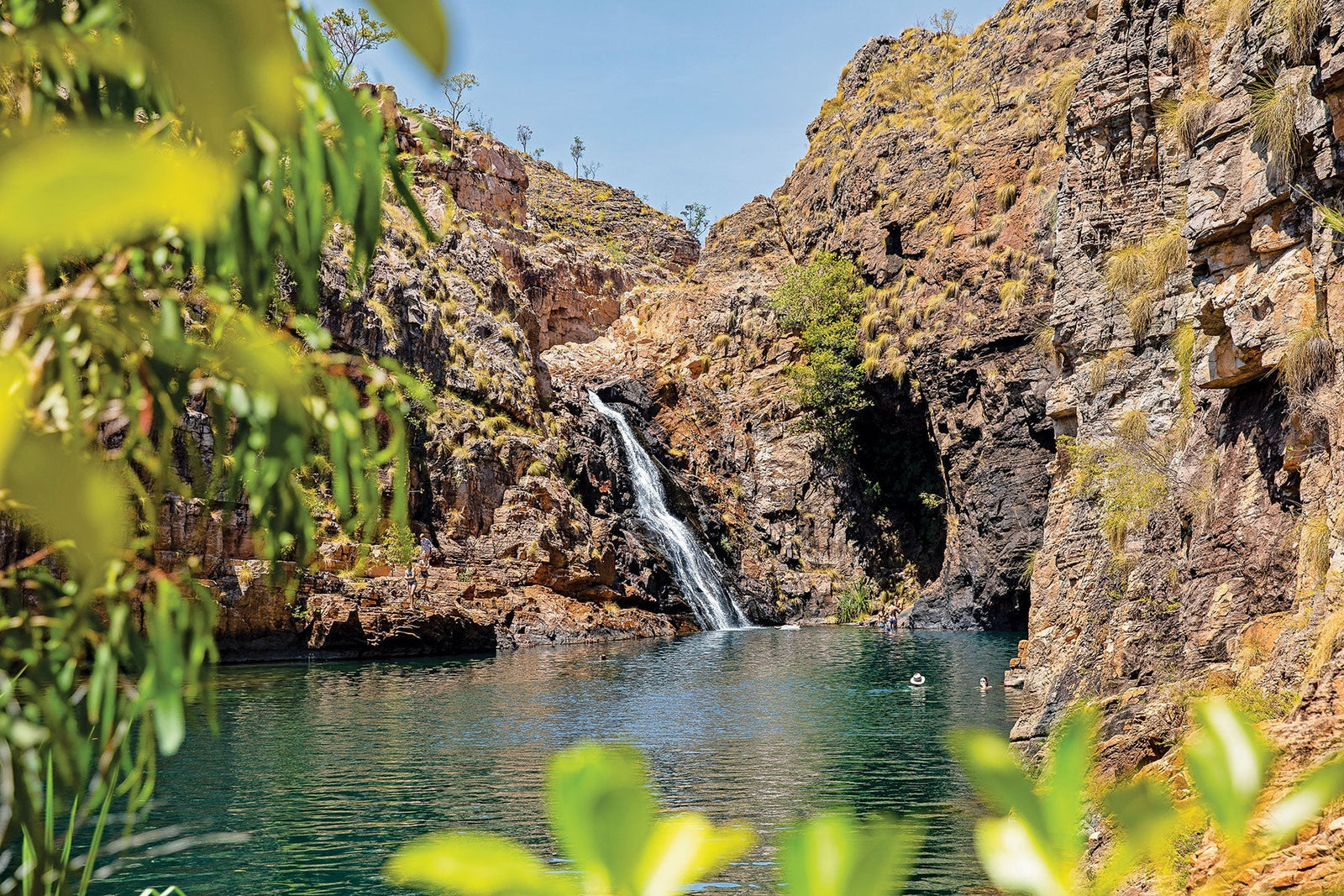
The Northern Territory's Kakadu National Park is unlike any other national park in Australia — well, except for one. It joins Uluru-Kata Tjuta National Park as a World Heritage-listed Park for its cultural and natural significance. Although it may not have an iconic colossal red rock as its unique selling point, Kakadu's varied landscapes make it just as remarkable to roam.
But before I get into what makes it such an outstanding patch of land, let's delve into its vastness. Kakadu is a whopping 19,816sq km. It's comparable with small countries such as Slovenia (20,271sq km) and Fiji (18,272sq km). Clearly, there is a lot of ground to cover when exploring one of the country's largest national parks, but where to begin?
The park has been occupied for more than 65,000 years. Stories from its former ancestors have stood the test of time, and the park is abundant with intricate rock art and carvings superimposed over one another throughout.
Besides cultural lures, Kakadu's colourful and complex ecosystems make it an extraordinary place to explore on land, boat and air. And trust me, you'll want to do all three to appreciate its mishmash of landscapes: stone country, savannah woodlands, hills and ridges, wetlands, tidal flats and coast and the outliers. Within these distinct environments are copious flora and fauna native to the park. So, as you can imagine, it's quite the stunner at every head turn.
And if you only have a few days to explore this park, it can be hard to decide what to see and do. I'll share my tried and tested ways to make the most of Kakadu, shall I?
Village in the outback
Continuing from our June adventures in Katherine (as seen in issue 639), my sister and I headed 255km northwest to arrive at Ngurrungurrudjba (Yellow Water) Campground and Caravan Park and Cooinda Lodge. Under one management, it offers something for everyone — from a perfect place to pull up the camper on grassed lands to luxury glamping retreats, complete with a bathtub on a deck shaded by tall paperbark trees. How's that for soaking in the scenery?
The outback village felt reminiscent of El Questro's The Station (WA), with its cafes and adjacent open-air bistro bar. The village’s pool area is an oasis, a rare dip in the NT almost guaranteed to be croc-free. The village also has an onsite petrol station, convenience store and tour desk. Cooinda Lodge is a perfect base and is well-positioned to explore Kakadu's most famed attractions on all kinds of transport.
A view from above
You can get a great overview of Kakadu's enormity and blended landscapes on a joy flight. Kakadu Air offers airborne tours from 30 minutes to full-day air and land adventures. Departing from Jabiru, 62km northwest of Cooinda Lodge, we opted for the 30-minute fixed-wing flight for just $150 per adult.
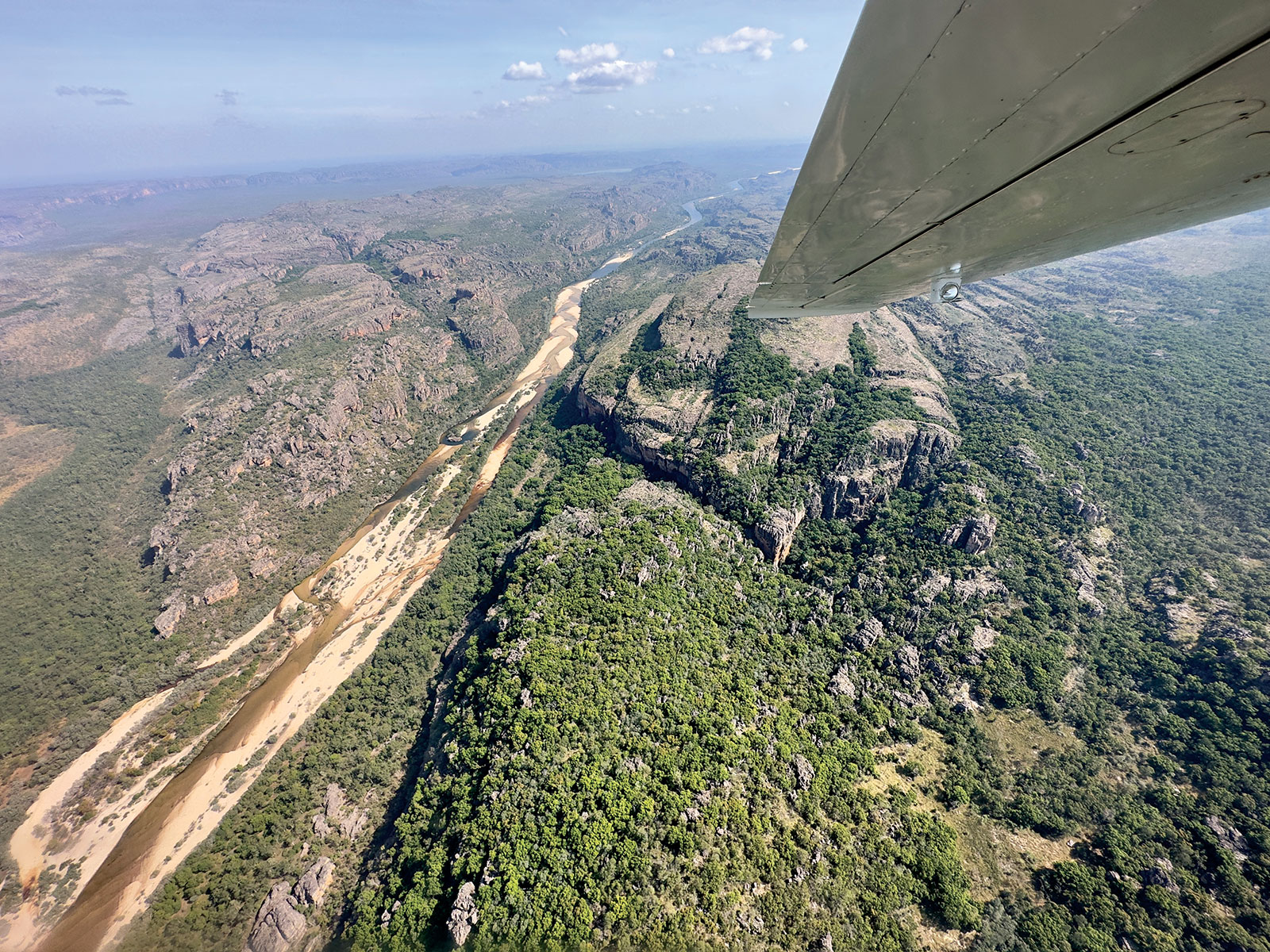
I was glued to my window in wonder, soaring over stone country — once sandstone plateau sculpted over time into a series of cliffs, gorges and deep crevasses — in neighbouring Arnhem Land. The surface below modelled a green and grey marble effect, with dense forest swirling between stony valleys.
One rocky outcrop stood out amid the giant jumble. Dubbed 'The Archway', the natural arch exemplifies the erosion this ancient land has experienced, perhaps the country's original 'coat hanger' landmark (sorry, Sydney Harbour Bridge).
The stone country was split in two as we flew over East Alligator River. The river was also divided, one part filled with darkened water and the other half thirsty — the effects of the dry season. A zigzag of blond and beige sand journeyed up the river like a rectilinear snake crawling between crevices. With the scenes switching below me, it was hard to decide where to look.
The landscape morphed into grasslands, with trees appearing like broccolis in Mikinj Valley. I enjoyed a glance at the green fields before we zoomed over Magela Floodplain — a freshwater lagoon filled with snappy inhabitants.
There was a lot to see in our half an hour of airtime, and it made me even more excited to hit the ground running and start exploring Kakadu on foot. Although, the airport terminal’s display of NT News newspaper’s front-page clippings featuring headlines such as ‘A croc walks into a bar’ and a croc ‘as big as a truck’ alongside bizarre imagery did make me reconsider getting too close to croc country.
Not your typical crossing
A half-hour drive (42km) north of Jabiru is where you can witness tomorrow's potential headlines unfold. Cahills Crossing is one of the region’s best places to observe crocodiles at play like it’s a spectator sport.
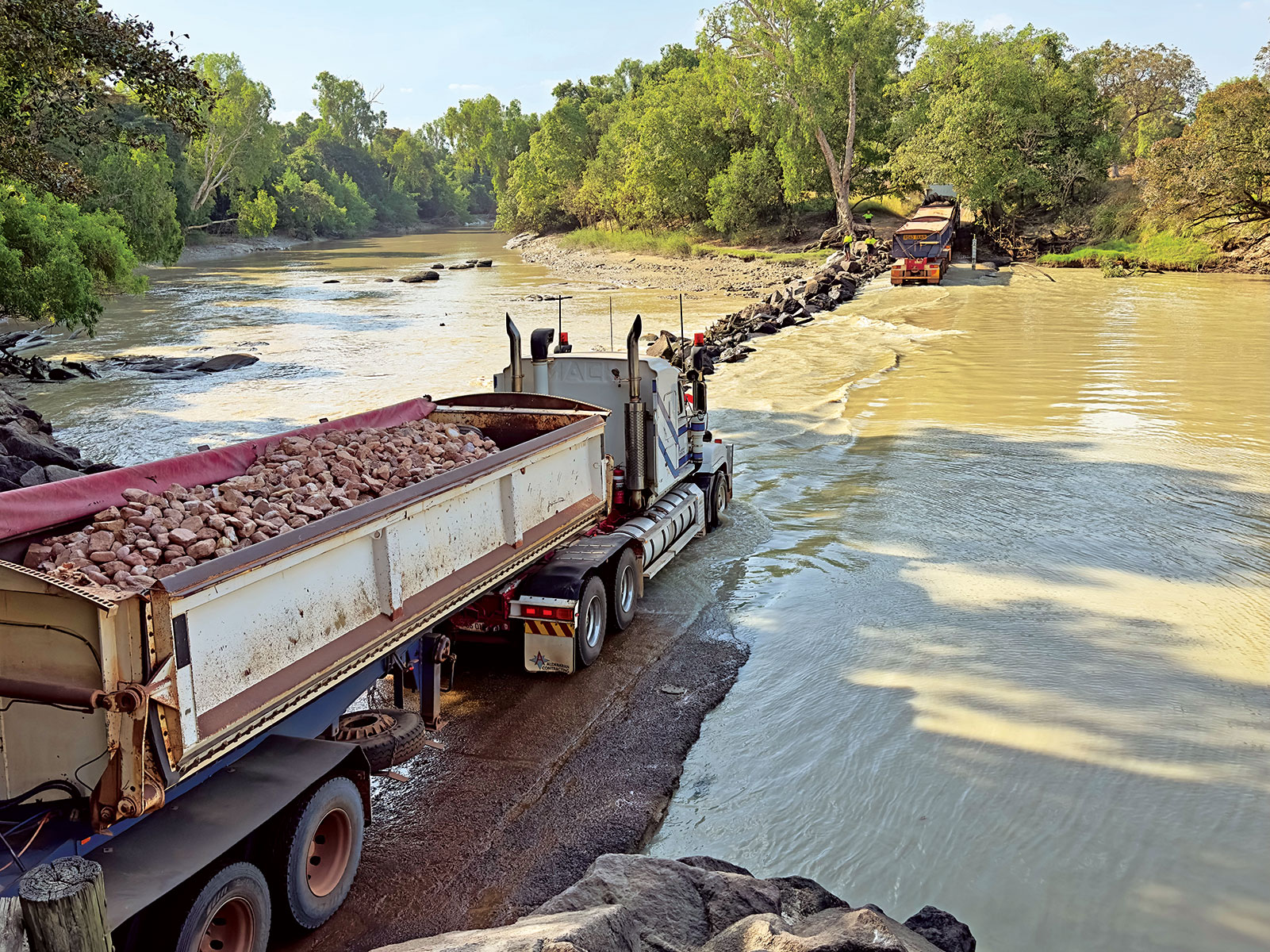
The causeway along the East Alligator River is notorious for its many saltwater residents sharing passage with road trains and high clearance 4WD vehicles. Cahills Crossing is the only road access point between Kakadu and Arnhem Land, with a permit from the Northern Land Council (NLC) required to make the daring drive (nlc.org.au).
I would not be one of those brave enough to take the wheel, but I was more than happy to observe all the action unfold. The area has three viewing platforms along the western bank of the river to watch the congregation of salties safely. It's advised to check ahead for tide times during the dry season as it will impact what unusual scenes will unfold (the crossing is usually closed during the wet season as water levels are too high).
At high tide, vehicles are unable to pass the river, with crocodiles able to do their thing — swim, feed — without the disruption of infrequent waves from oncoming traffic. While low tide permits vehicles to traverse the single road with crocodiles lurking in murky olive-green waters beside it.
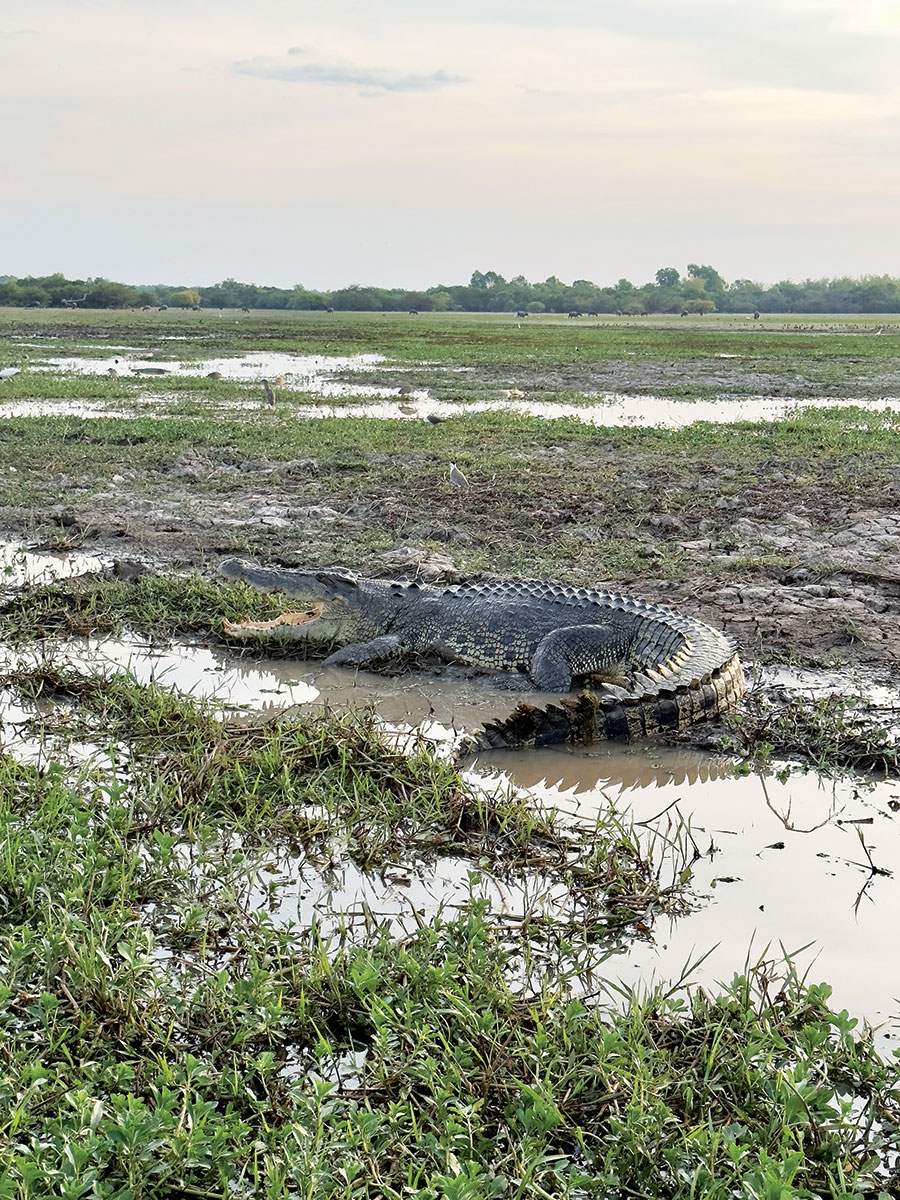
We had arrived just after high tide, with water still flooding the causeway, not to mention some dark shapes that made us pause. Is it a stick? Is it a log? Exposed body parts — heads, scaly backs and tails — appeared above water level, and it was fun deciphering what was what.
More thrills came when a road train entered the scene. The heavy load slowly pushed through the river, with nearby crocodiles nonchalant about their sudden upheaval. It's a real man versus wild moment, with drivers just metres from predators. It was a gripping watch with all the suspense and abnormal scenes of crocs and trucks coming head-to-head. It sure is a different world out here.
Please note: Do not venture outside the designated viewing platform areas to see the saltwater crocodiles.
Uncovering ancient artworks
Within Kakadu's unparalleled sceneries are ancient stories, many of which have been displayed for thousands of years.
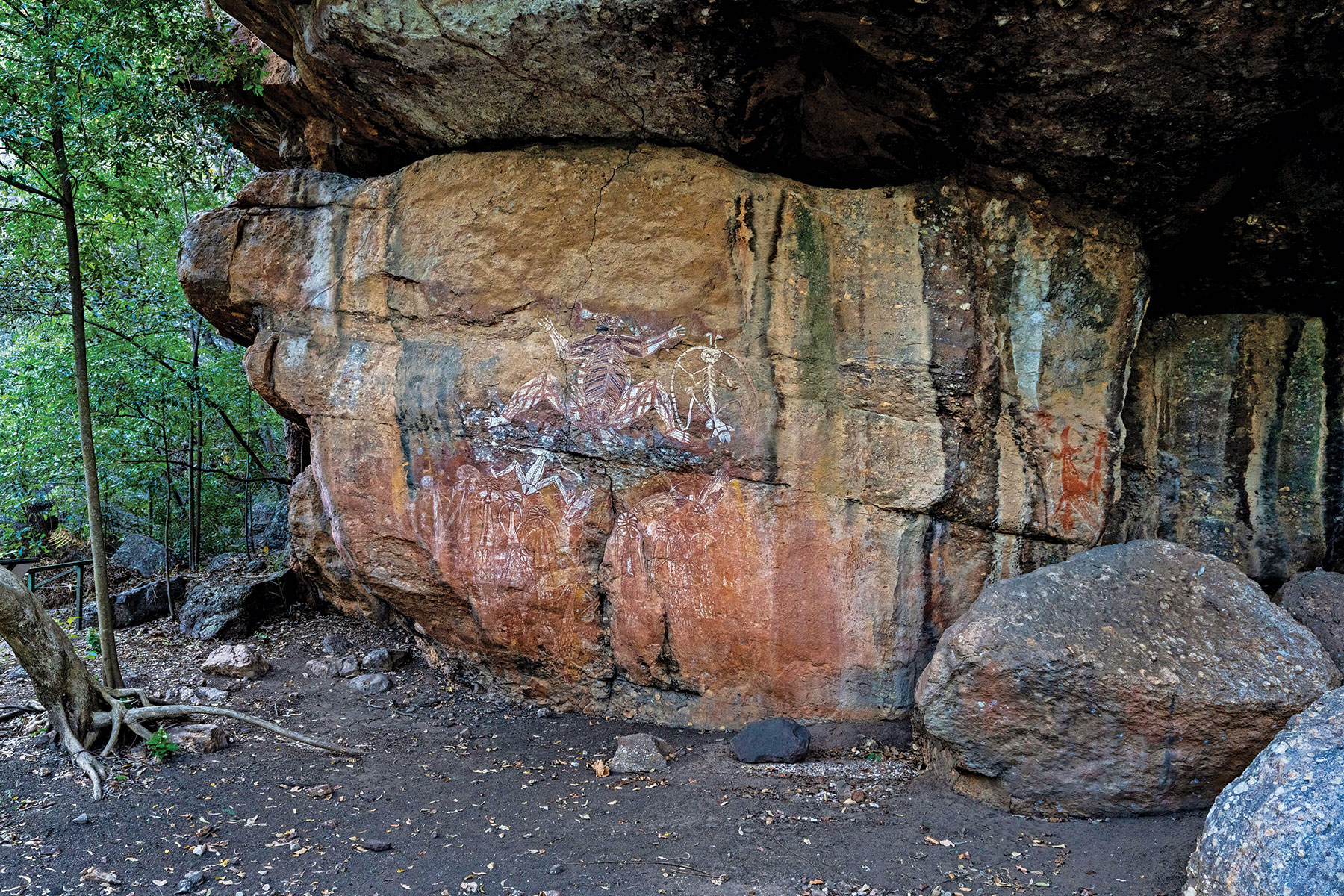 Nourlangie Rock Art Kakadu (Image Tourism NT)
Nourlangie Rock Art Kakadu (Image Tourism NT)
We joined local Murrumburrah tour guide Mandy Muir of Kakadu Billabong Safari Camp to understand artwork at the sacred site, Nourlangie, locally known as Burrungkuy, 44km east of the Cooinda Lodge campground. Mandy instantly proved to be a walking encyclopedia of the World Heritage-listed site, having led tours in the area for more than 35 years.
"I love visiting this place. It always refreshes me," Mandy told us as we hiked along the Burrungkuy main gallery and shelter walk.
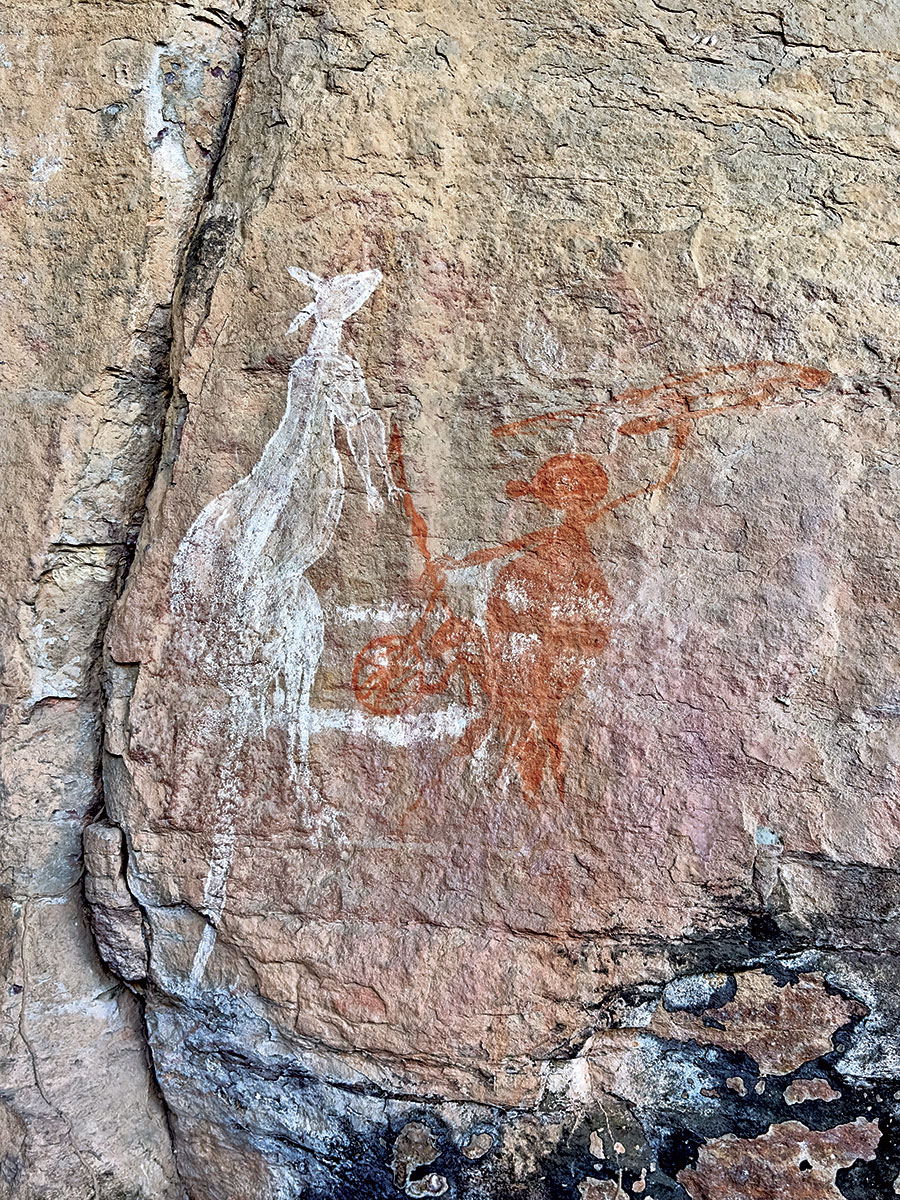 Rock art at Burrungkuy (Nourlangie)
Rock art at Burrungkuy (Nourlangie)
It took us roughly two hours to complete the moderate 1.5km loop. Mandy was forthcoming with knowledge, providing in-depth information about native flora and fauna and a bounty of figures drawn on overhangs and cliff faces.
"Some of our figures are drawn in weird and wonderful ways," Mandy said as we observed the intricate and well-preserved painting of creation ancestor Namarrkon, or the Lightning Man, one of the park’s most famous drawings in the Anbangbang gallery. The influential Dreamtime figure has axes on his head and is surrounded by lightning.
From Kunwarddehwardde lookout, three pillar-like cliffs along the Arnhem Land escarpment are believed to be the home of Lightning Man — a sacred yet dangerous place to venture, according to Lightning Dreaming.
Another rock gallery that is a must-visit is Ubirr, 93km north of the campground. The park is regarded as one of the world's finest collections of rock art, famous for its x-ray paintings and contact art recording early encounters between the Traditional Owners and European explorers.
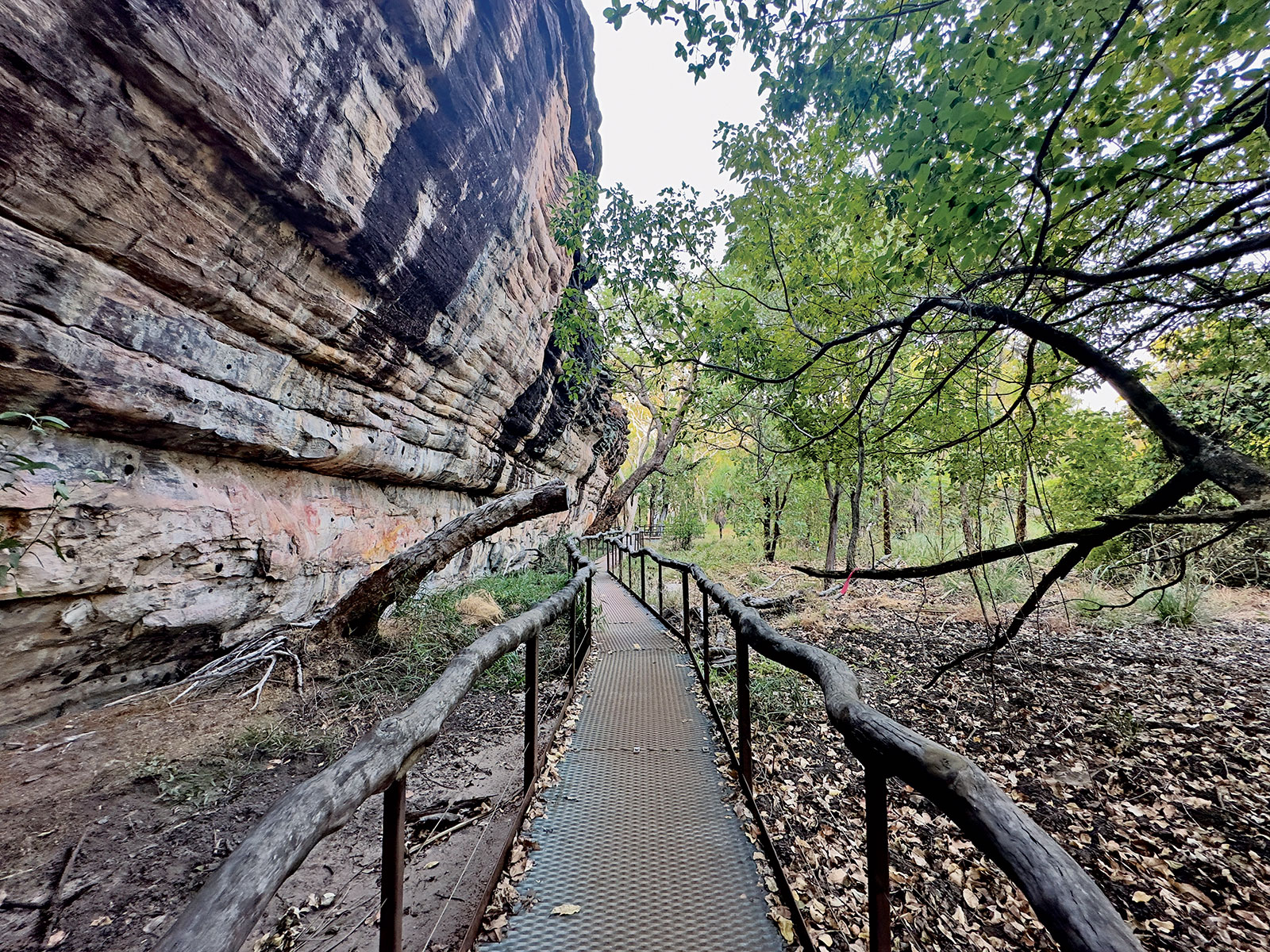
The best time to visit Ubirr is in the early morning or late afternoon. We opted for the latter, joining a rock art tour at 4.30pm during the dry season. It was a one-of-a-kind tour with Indigenous guide/joker Oscar Cooper at the helm, guiding a prominent percussion around the sacred site. We walked in the shadows of cliffs to view the numerous outback masterpieces, including the Rainbow Serpent — one of the most powerful ancestors in Creation Time. After 1.5 hours of jokes intertwined with cultural curations, we wound our way up onto the plateau. It's a perfect vantage point to appreciate a Top End sunset and see Kakadu's immense landscape change colour. A stirring experience.
Cruising along
Another incredible way to enjoy a sunset is cruising Yellow Water Billabong, next door to Ngurrungurrudjba (Yellow Water) Campground and Caravan Park and Cooinda Lodge. The wetland is one of the park's top tourist destinations, famed for its abundant and unique wildlife at the end of Jim Jim Creek — an offshoot of the South Alligator River. The entire river system is within the national park and is worth the distance to explore.
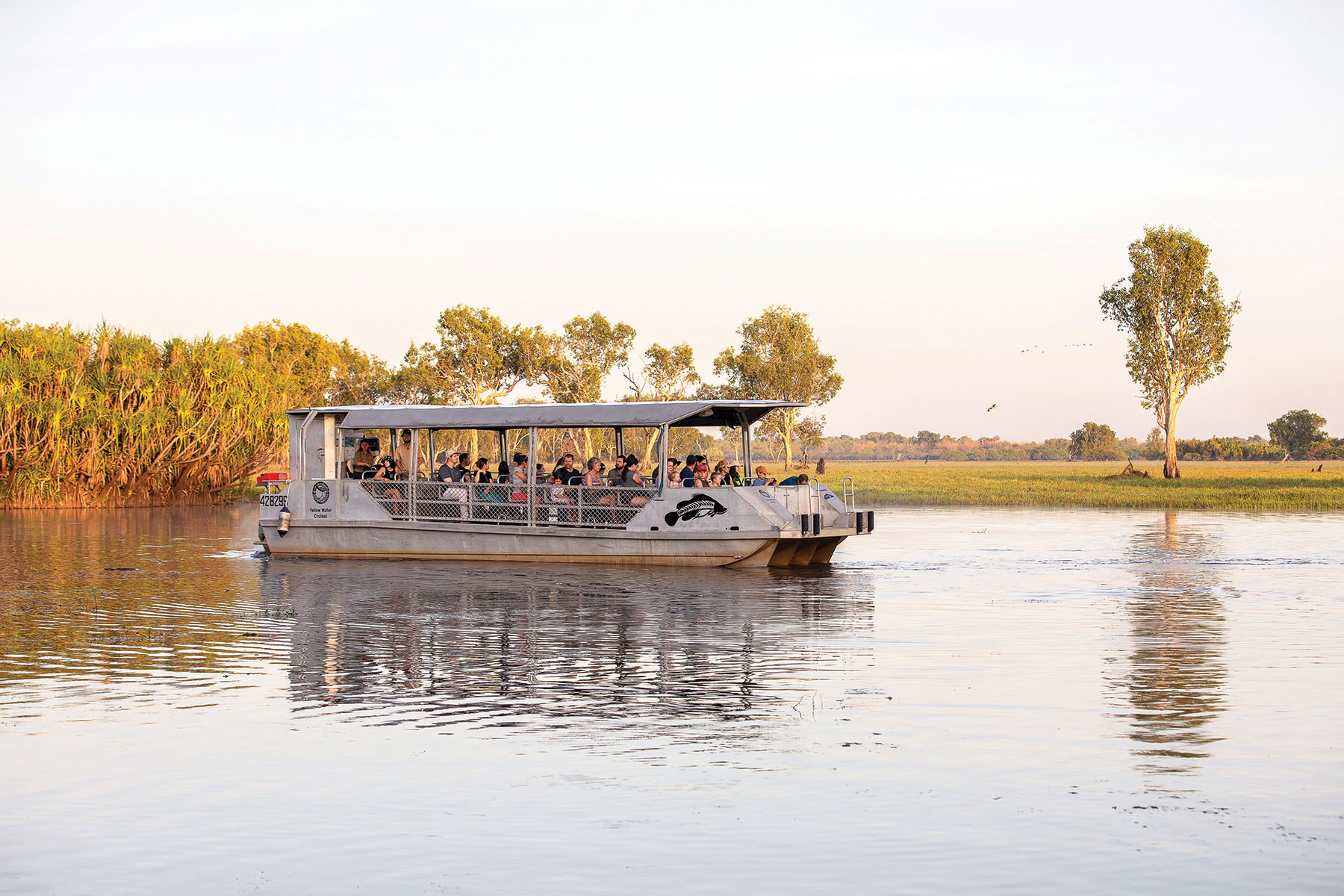 Yellow Water Cruise (Image Tourism NT)
Yellow Water Cruise (Image Tourism NT)
Multiple 1.5-hour cruises are available throughout the day; however, mornings and sunsets are optimal for witnessing wildlife activity. These cruises are a must for birdwatches — at least 60 bird species, including whistling ducks, white-bellied sea eagles and magpie geese, are found frolicking in the Yellow Water Billabong’s darkened waters. The birdsong and squawks create a beautiful ambience.
Other than birds, the famous wetland is a haven for freshwater crocodiles. We spotted a few in tall grasses and mangroves, pulling up the boat to closely examine these predators. Many appeared camera shy, quickly submerging into the water, and we were all wondering if we’d get to see one up close.
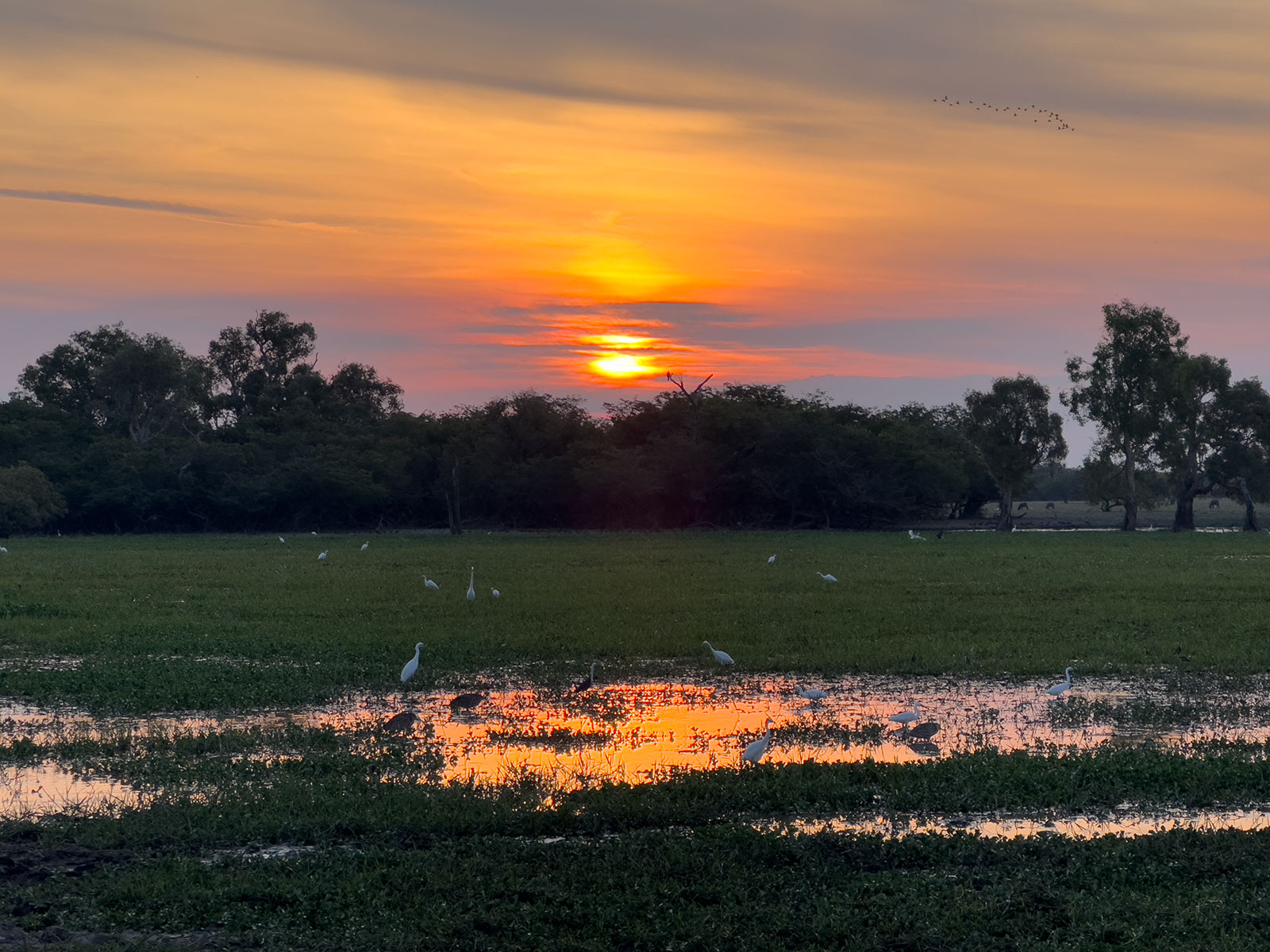
The boat pulled into a small inlet dubbed 'honey hole' — an ideal spot to observe the sunset and abundant wildlife. Its name quickly became apparent. Most of us onboard didn't know where to look. So much activity was happening in the air, water and on land. It was the ultimate showdown. More than 10 crocodiles surrounded the boat; a few stood frozen with mouths opened, such terrifying living statues. Being within metres of these sharp-toothed predators was intimidating, yet I loved the suspense of sneaky movements, a sudden splash here and there. Birds flapping about. It was a lot to take in, running back and forth between sides of the boat to the park's residents' movements. Riveting stuff.
The comedown
There are plenty of places to cool off in Kakadu with its myriad waterholes. We opted to head to Maguk, approximately 61km south of the campgrounds. But to access the hidden utopia is not without effort.
After traversing 14km along an unsealed road, it's a 1km easy hike through monsoon rainforest and across rock-strewn terrain to arrive at the sacred site's natural waterfall and plunge pool. We couldn't believe our fortune, having this oasis cloaked by gorge walls to ourselves. For the most part, Kakadu always makes you feel that way, like you’re the only explorer out there. After all, it's big enough.
Fast Facts
Please note, you will need a Parks Pass to enter Kakadu National Park. These can be purchased online and are valid for seven days.
Kakadu Air
P: 1800 089 113
E: reservations@kakaduair.com.au
Kakadu Billabong Safari Camp
P: 0499 326 753
E: murdudjurlkakadu@gmail.com
Ngurrungurrudjba (Yellow Water) Campground and Caravan Park
P: 08 8979 1500
E: camping@yellowwater.com.au
Yellow Water Cruises
Book at the tour desk at Ngurrungurrudjba (Yellow Water) Campground and Caravan Park or online.
 Yellow Water Billabong (Image Tourism NT)
Yellow Water Billabong (Image Tourism NT)







